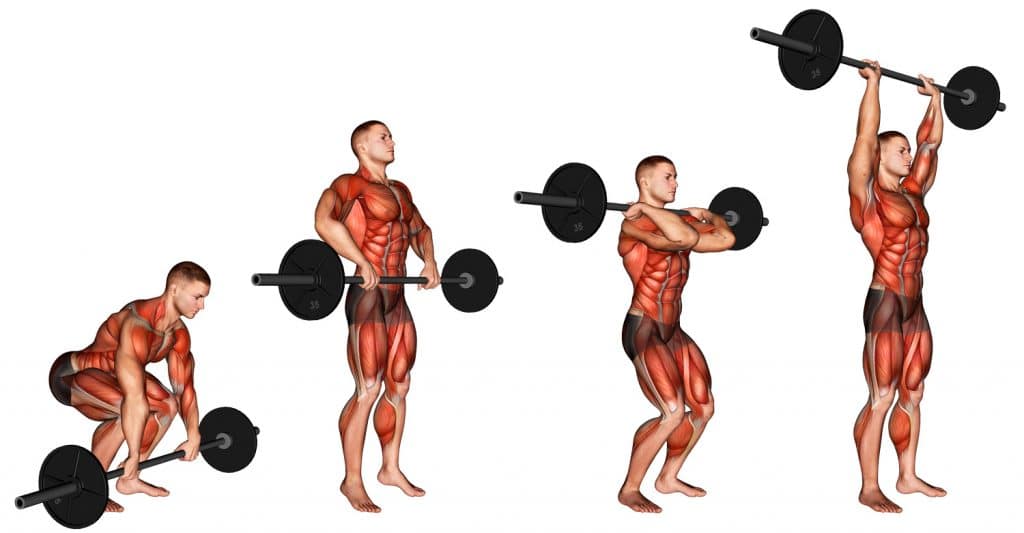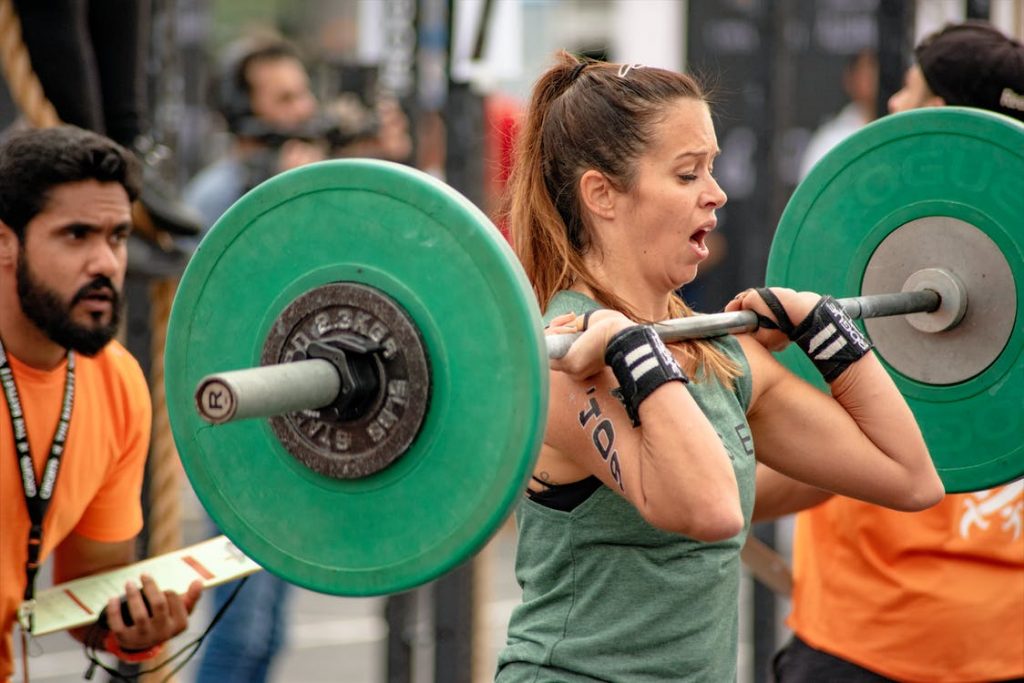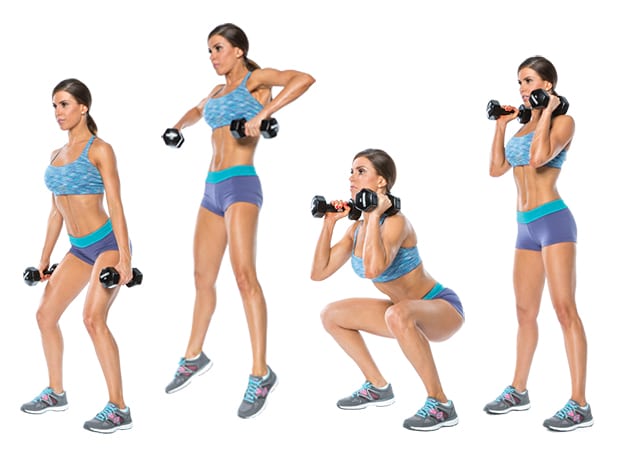This article has been reviewed by certified personal trainer Christopher Stadnik scientifically and practically.
The clean and press is a brilliant strength-training exercise for power, strength, cardiovascular endurance, and muscular endurance. Strength and speed go hand in hand with the clean and press with tons of benefits. You’ll be surprised by the amount of clean and press muscles worked!
If you’re wondering how to do a clean and press, you’ve come to the right place! Here’s a step-by-step guide to help you!
- What is Clean and Press?
- What Muscles Work in Clean and Press?
- Benefits of clean and press
- Step by step instructions to do clean & press
- Mistakes to avoid when doing a clean & press
- How to do the clean & press?
- Starting Position
- Barbell Clean
- Press
- How many sets of clean & press?
- Barbell Alternatives for Clean & Press
- What's clean and jerk?
- Difference between Clean & Press and Clean and Jerk
- Safety and Precautions
- FAQ
What is Clean and Press?
Everybody can perform the clean and press as part of a regular strength training routine. This body muscles building exercise combines two core strength-building moves – the power clean and the overhead press. Starting with lighter weights is a good idea if you are new to the clean and press.
What Muscles Work in Clean and Press?
Now we get to the question, “What muscles are engaged during clean and press?”
Clean and press are a giant and awesome compound exercise that engages almost all major muscle groups, including shoulders and a wide variety of upper body, lower body, and core muscles:
- Traps
- Triceps
- Biceps
- Forearms
- Latissimus Dorsi
- Rhomboids
- Lower back
- Abs
- Chest
- Calves
- Glutes
- Quadriceps
- Hamstrings

Benefits of clean and press
In our daily lives, we often pick up objects off the floor and put them back on shelves. In other words, we clean and press on a daily basis. As part of an Olympic lift, over eight different muscle groups are engaged in the clean and press. By the lower half of the movement, Olympic lifters experience strengthened hips, hamstrings, and glutes, while the upper half targets their shoulders, chest, back, and arms.
- Strength
The clean and press is most notable for enhancing your strength. Heavy lifting involves many different muscles and is excellent for building total-body strength.
- Hypertrophy
If you’re looking for an upper-body workout with aesthetic appeal, the clean and press is the right choice for you! As a result, the X-shaped physique is achieved by emphasizing the legs and shoulders.
- Burns fat by increased metabolism
As a compound clean and press exercise, this athletic muscle-building exercise uses a larger number of muscles, effectively burning more calories and burning fat. Result: you burn more fat and calories.
- Minimal Equipment
It may surprise you, but this compound movement that activates the major muscle groups can be performed only with a single piece of equipment.
Step by step instructions to do clean & press
When it comes to full-body weightlifting exercises, cleans and presses are among the most effective full-body weightlifting exercises.
Step 1:
Place your feet shoulder-width apart and hold the barbell approximately 2 inches away from your shins. Put your hips back and grab the barbell so that your hands are shoulder-width apart and your palms face you. Lift your chest, look forward, and keep your arms long.
Step 2:
Keep your core very tight and pull the bar up to your chest just above your collarbone by pulling through your heels. Maintain an upright posture. Hold the bar close to the body while pulling, being explosive and fast in your movements. Pull the bar underneath your shoulders by shrugging your shoulders and pointing your elbows forward.
Step 3:
Pull the bar directly to the overhead position and straighten your legs and arms and as soon as the bar reaches your chest. Be sure to maintain the core tight as you do this. Step back into your start position with control.

Mistakes to avoid when doing a clean & press
By avoiding these common mistakes, you can enjoy this exercise to the fullest while avoiding strain and injury risks.
- Bending backward
The most common mistake made during the press phase of the exercise is holding the weight behind the head. Clean & press techniques require moving the barbell in a straight line. Avoid rounding your back as you lift the weight, especially for heavyweights. Keep an upright posture.
- Clench position
The risk of wrist pain increases if your grip is 2 inches wider than your shoulders. If you clench too narrowly, it can strain your shoulders.
- Keep the weight close to the body
The starting position should be at a distance of 2 inches from your shins behind the barbell. When you lift the bar, it should be in a straight line up your body. Lifting will be more difficult if that’s not the case.
A common form mistake during the clean and press is to move the barbell forward away from the body, like swinging it. To pull the weight back up to your shoulders, you will need more upper body strength. With this exercise, more load is placed on the biceps, while with the clean, more emphasis is placed on the posterior muscles. During the clean and press, put your weight on your heels.
Swinging the bar makes the exercise more difficult and reduces the weight that can be lifted, decreasing the strength and hypertrophy benefits of clean and press activities.
- Using too little weight
As a compound movement, the clean and presses work many muscles, so you can lift more than isolation exercises. It’s because you can – and you should – lift more.
To effectively work all of the clean & press muscles, it is necessary to use a lot of weight rather than lighter weight. The move will only work the biceps, shoulders, and triceps with too little weight, thereby neglecting to work the posterior muscles.
- Pulling Off the Ground Too Fast
When someone new to strength training quickly pulls the bar from a dead stop, the second portion of the pull is less effective. Keep good form during the clean and press deadlift segment, and save your speed for the second pull. Thus, the barbell can be pulled with power from knee height to shoulder height.
Our recommendation is to use a weight that you can just about handle for all reps.
The last one or two should be challenging! For the entire set, you must pick a weight that you can maintain proper form with.
How to do the clean & press?
Depending on your fitness level and expertise, you can use dumbbells or a barbell to perform the exercise. Amateurs can begin with an empty bar. Use mirrors to ensure that your body is doing what you want it to do.
Starting Position
- Place your feet shoulder-width apart behind a loaded barbell.
- Make sure that the bar is only 2 inches away from your shins as you stand close to it.
- Put your knees bent and thrust your hips back to seize the bar, situating your hands shoulder-width separated and employing a twofold overhand hold.
- The shoulders should be over the bar, and the elbows should be pointed outward.
- Maintain a flat back throughout the exercise.
Barbell Clean
- When deadlifting, drive through your heels to raise the bar to your knees. Keep it close to your body while extending your knees and hips.
- The clean starts from this position.
- It would help if you extended your ankles, knees, and hips with the power to drive the weight to your shoulders when the barbell is at knee level.
- Shrug your shoulders and drive your elbows under the bar.
Press
- When you hold the bar across your shoulders in the rack position, drive through your heels to press it up.
- Extend your arms as you press the bar upwards (don’t lock out your elbows).
- Lower the barbell to your shoulders at a controlled pace by reversing the movement.
- Return to the original starting position.
How many sets of clean & press?
Depending on your exercise goals, the recommended sets and reps will vary. So, try five sets of 5 repetitions if you are trying to build muscle strength.
For muscular endurance, try 2-3 sets of 18-20 reps; 4 sets of 8-12 reps are also suggested for aesthetic purposes.
Barbell Alternatives for Clean & Press
However, the barbell clean and press is a fantastic exercise that offers tons of benefits for pretty much every gym-goer, though some may find it challenging. Don’t worry! You can do variations that burn just as many calories as meeting your training goals. The first is dumbbell variation.
1- Dumbbell Clean & Press

No matter what the exercise is, dumbbells are a great tool. Their obvious advantage is their ability to move freely. In addition, compared with a barbell clean and press, dumbbells also pose a lower risk of injury.
How To Do a Dumbbell Clean & Press?
Step 1: Make sure your tailbone is tucked under slightly, and your pelvis is parallel to the ground. Engage your core by pulling down on your ribs.
Step 2: Keep your ribs down as you press the weights straight overhead to lockout. To lower the weights to the floor (or your knees), then, reverse the motion to raise them to shoulder height level.
2- Kettlebell clean & press
The second barbell alternative activity is the kettlebell variation. Moving the weight around the hand makes kettlebells a valuable training tool. However, you can injure your hands and wrists if done incorrectly. Take a look at this Kettlebell Swing to avoid any risk of injuries.
Kettlebell Exercise Guide
- First of all, with the handle horizontal, place the kettlebell between your legs or in front of you so that the pronated overhand grip is easy to use.
- Aim for about hip width between your feet or adjust based on what feels comfortable. Avoid going too narrow or too wide.
- Hold the kettlebell at a slightly diagonal angle rather than straight across (e.g., the handle should start high near your thumb and angle down to the bottom of the wrist directly under your pinky finger).
- Swing the kettlebell back and forth while bending your knees.
- As if zipping up your jacket, thrust your hand upwards and pull the kettlebell upwards towards your neck. Your palm should be facing away from you as you rotate your wrist. Maintain mostly straight forearms, with only a slight angle toward the midline. Kettlebells should land between the forearm and bicep.
- As you dip down and explode upward, keep your arm close to your head as you press the kettlebell overhead. A strict press can also be done without using the legs or hips.
- Finally, repeat the movement in the opposite direction.
Single-Arm Kettlebell Clean
A single-arm kettlebell clean or a kettlebell clean is a weightlifting activity for upper body muscles and lower body. Stand in front of a kettlebell and open your feet slightly wider than shoulder width to perform this exercise.
What’s clean and jerk?
This exercise is a dynamic movement that involves muscle recruitment, including the shoulders, quads, core, and glutes. Moreover, it’s one of the two competition lifts in weightlifting. Proper clean and jerk combine three movements: a deadlift, a clean, and an overhead press. To master the clean and jerk, you need patience, skill, and adequate time.

Steps to do the clean and jerk
Follow these steps to properly perform a clean movement and jerk. It’s the same as clean and presses, ending with the barbell in the front rack. Jerks are traditionally done in the split jerk style. Dip your legs into the lifting position; pull the bar away from your shoulders while dropping slightly below the bar for a wide and stable stance.
Within seconds, your arms will extend into the hold. Hold your splits for a few seconds, and then bring your front foot back to the center line, followed by your back foot. Place both feet together with the bar overhead to complete the lift.
Clean and jerk benefits
- Enhances athletic development by maximizing the use of power.
- Clean and jerks are one of the most effective ways to lift heavy object overhead.
Difference between Clean & Press and Clean and Jerk
After all, knowing the differences is fine, but incorporating them correctly into your workout routine will help you see actual results.
Both skills require a clean, so the difference lies in how you finish. The press is primarily an upper-body movement, whereas the jerk is a powerful leg drive movement.
- Weight load
The jerk allows you to lift more weight than the press because you rely solely on your shoulders, triceps, and upper back during the strict press. By pushing the bar high off your shoulders in the jerk, you use all the power of your legs. As the bar ascends to arms’ length, your arms exist only to “catch” it.
- Difficulty level
Jerks are more technical than presses. You need a good form, exact timing, and excellent coordination to perform well.
- Maximize your muscular strength
When using clean and jerk, the most weight will be loaded onto the bar. So, bringing your legs and arms to the party will make lifting a barbell over your head easier. Hence, you’ll enjoy maximum strength.
- Hypertrophy
It’s probably best to stick with clean & press when you’re trying to build muscle. More muscle power is required from the upper body to move the barbell. As a result, you’ll spend more time under tension, which will lead to bigger shoulders and arms.
- Performance in athletics
Presses and jerks require coordination and awareness to function correctly. The two lifts deserve a spot in your workout if they don’t interfere with other athletic activities.
Safety and Precautions
If you suffer from ankles, knees, hips, wrists, shoulders, necks, or back problems, consult your physical therapist or doctor. Pregnant women are not permitted. Last but not least, if you feel any sharp pain during the workout, stop.
Harvard Health Prostate Knowledge suggests the following guidelines to keep in your mind as you work through:
“If you’re just beginning, start by lifting small amounts of weight to avoid straining a muscle or injuring yourself. Choose a weight that’s comfortable, but challenging. If you can’t comfortably do eight.”
“Lift the weight slowly. Take about three seconds to lift it, hold the position for a second, and then take another three seconds to lower it.”
“Breathe slowly, inhaling as you lift and exhaling as you lower the weight.”

Greetings! Very useful advice within this article! It’s the little changes that make the greatest changes. Thanks a lot for sharing!
Hi there to every body, it’s my first visit of this web site; this web
site contains amazing and really fine data for visitors.
Some really interesting details you have written.Helped me a lot, just what I was looking for : D.
Wow, wonderful weblog layout! How lengthy have you been running
a blog for? you make blogging glance easy. The whole look of your web site is wonderful, let alone the content!
This text is invaluable.
Great line up. We will be linking to this great article on our site. Keep up the good writing.